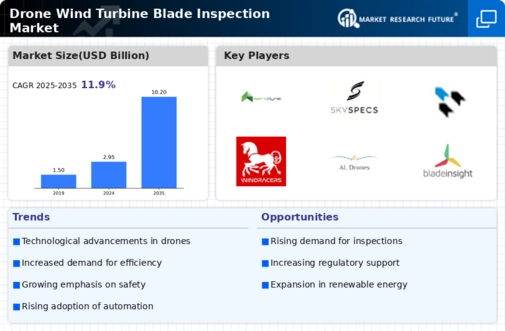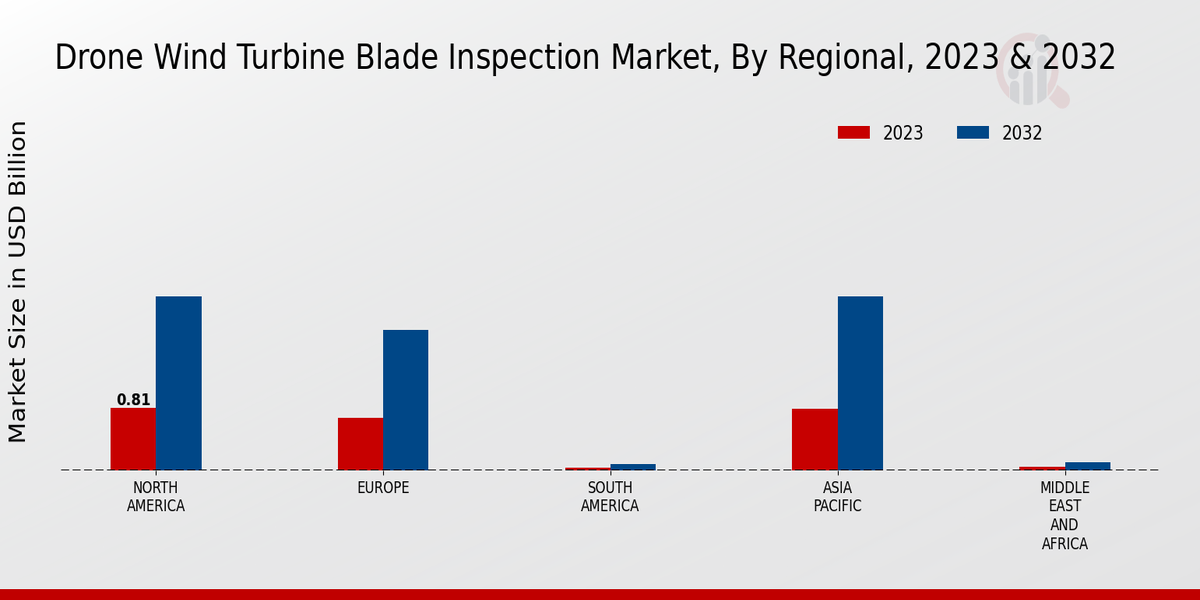Market Growth Projections
The Global Drone Wind Turbine Blade Inspection Market Industry is projected to experience substantial growth over the coming years. The market is expected to expand from 2.95 USD Billion in 2024 to 10.2 USD Billion by 2035, indicating a robust CAGR of 11.93% from 2025 to 2035. This growth trajectory reflects the increasing adoption of drone technology in wind turbine inspections, driven by factors such as technological advancements, regulatory compliance, and the growing demand for renewable energy. The market's expansion is indicative of the broader trends in the energy sector, where efficiency and sustainability are becoming paramount.
Cost Efficiency and Time Savings
Cost efficiency and time savings are pivotal drivers in the Global Drone Wind Turbine Blade Inspection Market Industry. Traditional inspection methods often involve significant labor costs and extended downtime for turbines. In contrast, drone inspections can be completed in a fraction of the time, reducing operational disruptions and maintenance costs. This efficiency is particularly appealing to wind farm operators who seek to maximize productivity while minimizing expenses. As the industry continues to recognize the financial benefits of drone technology, the adoption of drones for wind turbine inspections is expected to accelerate, contributing to the market's expansion.
Growing Awareness of Asset Management
The Global Drone Wind Turbine Blade Inspection Market Industry is witnessing a growing awareness of the importance of asset management among wind farm operators. Effective asset management strategies require regular monitoring and maintenance of wind turbine blades to prevent costly failures and extend their lifespan. Drones facilitate this process by providing real-time data and insights into the condition of turbine blades. As operators increasingly prioritize proactive maintenance and asset management, the demand for drone inspections is likely to rise, driving market growth and enhancing the overall efficiency of wind energy operations.
Increasing Demand for Renewable Energy
The Global Drone Wind Turbine Blade Inspection Market Industry is significantly influenced by the increasing demand for renewable energy sources. Governments and organizations worldwide are investing heavily in wind energy to meet sustainability goals and reduce carbon emissions. This shift towards renewable energy has led to a surge in the number of wind farms, necessitating regular inspections of turbine blades to ensure optimal performance. Consequently, the demand for drone inspections is expected to rise, as drones offer a cost-effective and efficient solution for monitoring wind turbine conditions, thereby supporting the industry's growth.
Regulatory Compliance and Safety Standards
The Global Drone Wind Turbine Blade Inspection Market Industry is also driven by stringent regulatory compliance and safety standards imposed by various governments. These regulations mandate regular inspections of wind turbine infrastructure to ensure safety and operational efficiency. Drones provide a viable solution to meet these regulatory requirements, as they can conduct thorough inspections without the need for scaffolding or cranes, minimizing risks to personnel. As regulatory bodies continue to emphasize safety in the renewable energy sector, the reliance on drone technology for inspections is likely to increase, further propelling market growth.
Technological Advancements in Drone Technology
The Global Drone Wind Turbine Blade Inspection Market Industry is experiencing rapid technological advancements, enhancing the capabilities of drones used for inspections. Innovations such as high-resolution cameras, thermal imaging, and LiDAR technology allow for more accurate assessments of wind turbine blades. These advancements not only improve inspection efficiency but also reduce the time and costs associated with traditional inspection methods. As a result, the market is projected to grow from 2.95 USD Billion in 2024 to 10.2 USD Billion by 2035, reflecting a compound annual growth rate (CAGR) of 11.93% from 2025 to 2035.


























Leave a Comment